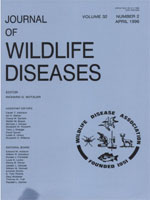In February 1993, clinical, pathological, and microbiological investigations were performed on an adult female gray fox (Urocyon cinereoargenteus) from northern Mississippi (USA). The fox had clinical signs consistent with canine distemper virus encephalitis. Eosinophilic inclusions characteristic of canine distemper virus were in the nuclei and cytoplasm of cerebral neurons and glial cells and in the cytoplasm of urinary, gastric, pancreatic and biliary epithelial cells. The liver contained multifocal microscopic nodular foci of granulomatous to pyogranulomatous inflammation and necrosis with large colonies of small Grain-negative coccobacilli. A low number of small Gram-positive bacilli were within viable-appearing Kupffer cells and hepatocytes. Yersinia pseudotuberculosis and Listeria monocytogenes serotype 4 were isolated from the liver and a mesenteric lymph node.
How to translate text using browser tools
1 April 1996
Isolation of Yersinia pseudotuberculosis and Listeria monocytogenes Serotype 4 from a Gray Fox (Urocyon cinereoargenteus) with Canine Distemper
Sharon S. Black,
Frank W. Austin,
Elise McKinley

Journal of Wildlife Diseases
Vol. 32 • No. 2
April 1996
Vol. 32 • No. 2
April 1996
canine distemper
encephalitis
gray fox
hepatitis
Listeria monocytogenes
Urocyon cinereoargenteus
Yersinia pseudotuberculosis




